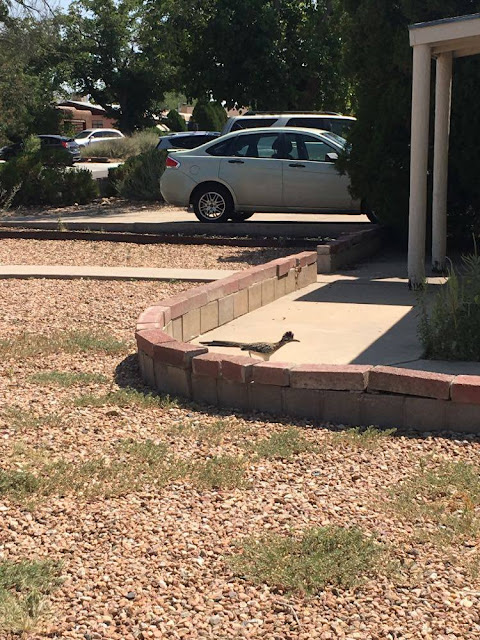All Kinds of Pests
It's another sleepy, dusty, desert day here in the lovely state of New Mexico. As I sip my coffee, the sun is slowly rising and the birds are chirping. I'm hoping a road runner scurries through our backyard. They seem to be most active in the morning. The road runner has been my favorite little creature we've encountered down here.
There's been lots of little creatures this week. Not all of them I have appreciated like the roadrunner. Many of them have been pests, and some have been thorny (see the nightshade above)! I had my first fumble as a gardener down here. One morning, I walked out to check on my plants, and my beans were covered in these gnarly, little gnats! Not much damage had been done yet, but I could see little holes forming in the leaves. I quickly ran inside, filled up a bowl with water, and headed back out. One by one, I plucked the little bastards off the leaves and into the water bowl, so they couldn't fly away.
The gnats, or what I suspect are actually Bean Seed Flies, collected in a bowl of soapy water
I knew just picking the little guys off wouldn't solve the problem. But, one of the main reasons I'm raising vegetables for Lily and me is to get away from the harmful pesticides used in industrial agriculture, so I didn't want to run to the store and buy one of the various bug killers you find on the store shelf. Luckily, the internet is chock-full of organic pesticide recipes. I came across one that seemed simple enough: neem oil mixed in water and a few drops of dish soap. Neem oil, for those who don't know, comes from the neem tree — a tree indigenous to the Indian subcontinent. In addition to its funky smell, the oil is a natural repellent to many insects, and it has been used as a natural pesticide for hundreds of years.
So, off I went to whole foods to peruse the essential oil aisle (not something I thought I'd catch myself doing) in search of this garden cure. When I came back, I mixed the oil with water in a spray bottle. Eager to get the little bastards off my bean plants, I sprayed the mixture immediately. Unfortunately, due to my eagerness, I did not fully read the instructions for using this neem oil cocktail. When you apply neem oil to a plant who is fully exposed to the sun's beating rays, it ends up burning the plant leaves. So, instead of having pest-ridden bean plants, I ended up with sun burnt bean plants!
The gnats were not the only pests in my garden this last week. Not long after planting the beets, Remy, bursting at the seams with energy, started zooming around and playing in our sandy backyard. This included zooming through my beet patch and ripping up some of the young, fragile beet plants! After corralling Remy inside, I quickly thought of a way of a way to "Rem-proof" my beet patch by building a small fence around it (made with some wooden stakes and jute string). I planted more beets, and I added dill and chamomile to the patch.
Not all the pests I interacted with this week were bad! Some days, I don't get around to watering my garden till after the sun sets. Once it sets, a whole new world opens up down here in the desert. One particular creature has captured my attention this last week: the cockroach ( the American cockroach). These little guys scurry around everywhere in the evening! At first, I was quite disgusted with them. After all, they are cockroaches! But not long after getting my compost bin set up, I noticed them hanging around the bin at night time. Although I have no desire to get too close to a cockroach, they help aide the decomposition process in composting, so I've learned to appreciate them. Opening up the lid of the bin, I discover not only a few roaches hanging out in the muck, but some white maggots (fly larvae to be precise) as well! But like the cockroach, the maggots help speed up the break down of food scraps into nutrient rich humus, or compost.
Towards the end of the week, Lily and I discovered another member of our backyard community: hummingbirds! Lily — with her wonderful, crafty ability — turned a Kikkoman soy sauce bottle into a dazzling hummingbird feeder, which we quickly set up outside and eagerly awaited for some hummingbirds to appear. For the first few days after putting it up, the hummingbirds would swoosh into our backyard to check it out, but they would never eat from it. Finally, one morning, a little gal suspended herself in the air and drank the sweet sugary nectar (baker's sugar and water stirred together). Since then, it's been an absolute joy seeing a dozen or so hummingbirds a day swing by for a refreshment. New Mexico, it turns out, is one of the best states in the union for viewing hummingbirds. There is over 18 documented species of hummingbirds that hang out in New Mexico — not too shabby! For now, Lily and I's new project is to turn out backyard into a pollinator and hummingbird paradise!











Comments
Post a Comment